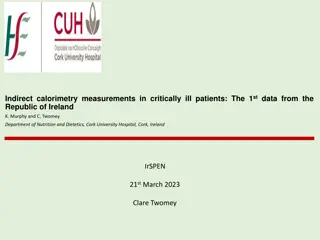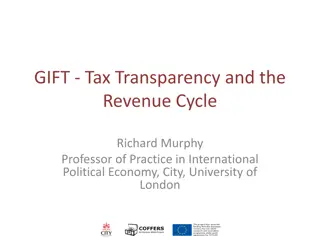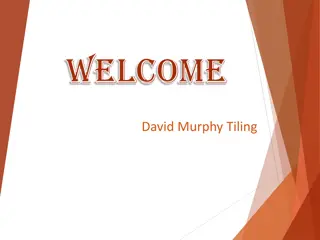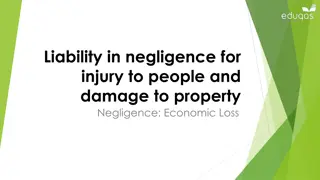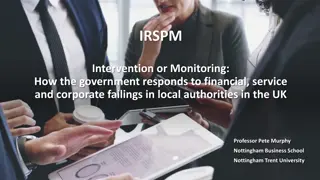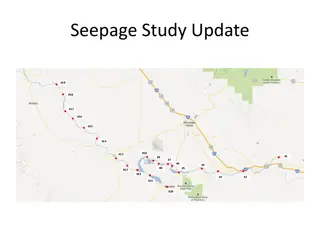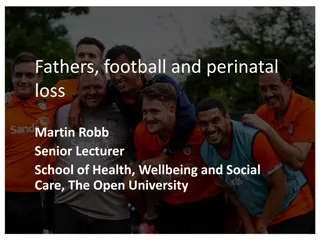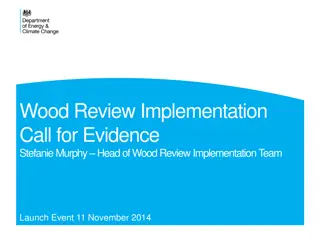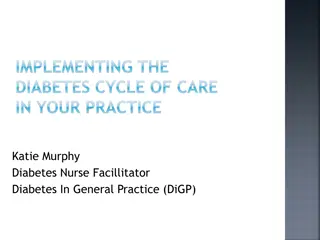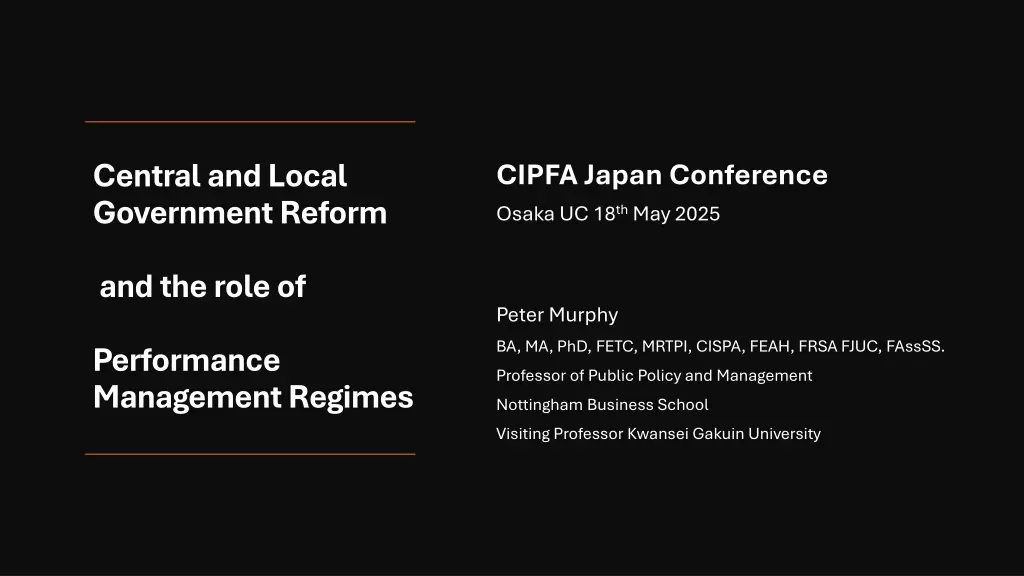
Peter Murphy: Professor of Public Policy and Management
Peter Murphy, a specialist in public policy and service delivery, focuses on performance management, governance, and value-for-money arrangements in public services. With a background in local government, he played a central role in designing and delivering performance management regimes. Explore his career journey from trainee planner to chief executive, addressing community problems and government modernisation along the way.
Download Presentation

Please find below an Image/Link to download the presentation.
The content on the website is provided AS IS for your information and personal use only. It may not be sold, licensed, or shared on other websites without obtaining consent from the author. If you encounter any issues during the download, it is possible that the publisher has removed the file from their server.
You are allowed to download the files provided on this website for personal or commercial use, subject to the condition that they are used lawfully. All files are the property of their respective owners.
The content on the website is provided AS IS for your information and personal use only. It may not be sold, licensed, or shared on other websites without obtaining consent from the author.
E N D
Presentation Transcript
Central and Local Government Reform CIPFA Japan Conference Osaka UC 18thMay 2025 and the role of Peter Murphy BA, MA, PhD, FETC, MRTPI, CISPA, FEAH, FRSA FJUC, FAssSS. Professor of Public Policy and Management Nottingham Business School Visiting Professor Kwansei Gakuin University Performance Management Regimes
I specialise in practically based and applied research and am interested in difficult problems. My focus is on public policy and public service delivery, and in particular the performance management, governance, scrutiny, public assurance, and value-for-money arrangements of public services. Research Interests Organised through 3 research units Central and Local Government Health and Social Care Emergency Services
Community problems facing local authorities Some historical highs Rapidly increasing wealth and health inequality Falling educational attainment, Social problems such as rising teenage pregnancies Prison Populations, overcrowding, offending recidivism, Rising crime and anti-social behaviour, Poverty, alienation and discrimination and community cohesion, Street homelessness.
They were among the service delivery and wicked problems facing Local Authorities in late 1990s The response was the Local Government Modernisation and Improvement regimes from 1997 to 2010 I experienced the rise of these problems when working in Local Government between 1977-2000 I became part of the central and local government response and had a central role in designing and delivering performance management regimes.
Dates Employer Posts Responsibilities 1977- 1979 South Bedfordshire DC 1. Trainee Planner 2. Planning Assistant 3. Planning Officer District Planning Conservation & Neighbourhood Planning Structure Planning Regional Planning (London & South-East) 1979- 1985 Derbyshire Dales DC. 1. Senior Planning Officer (Forward Plans) 2. Area Development Control (Central) 3. Area Development Control (South) 4. Economic Development Officer Regional, Strategic and Local Planning Planning Applications, Appeals, Enforcement Planning Applications, Appeals, Enforcement Regeneration, growth and development. 1985- 1987 Broxtowe BC 1. Principal Planning Officer (Forward Plans) 2. Acting Strategic Director, Planning, Architecture, Estates, Building Control Regional, Strategic and Local Planning and major appeals Acting Strategic Director (30% of council services) 1987- 1996 Hinckley & Bosworth BC 1. Chief Planning Officer 2. Strategic Director of Planning, Economic Development, Leisure & Recreation and Estates All Planning Services Strategic Director (45% of council services) 1996- 2000 Melton BC 1. Chief Executive, Statutory Monitoring Officer, Parliamentary Returning Officer, Emergency Planning Officer All Council Services All European, National and Local Elections. Emergency Planning and Response.
Local government is more than delivering services These 5 local authorities gave me experience of how to run (or recover) multiple local authority services, and I was asked to help other authorities in various problematic circumstances. Multiple Awards and policy and service delivery Innovations brought invitations to contribute to national and regional policies and initiatives They also brough Chairmanships and Non-Executive Director appointments across public, private and non-profit sectors. I was a member and office holder within four professional associations I acquired national and European experience, contributing to public inquiries, Parliamentary Select Committees, national policy initiatives and non-departmental public bodies (NDPBs)
Prior to 1979 UK tended to see more long-term incremental reforms -the UK had a reputation for political and economic, stability -perhaps even reliability? Since 1979 and Mrs Thatcher The 1979-1997 Thatcher/Major administrations replaced traditional forms of direct provision with competitive tendering, marketisation and outsourcing to private sector provision The UK has seen big radical swings The 1997-2010 Blair/Brown introduced Best Value and continuous improvement across all public services with devolution of powers to Scotland, Wales and N Ireland. in the strategic objectives and operational reforms 2010-2025 (Cameron, May, Johnson, Truss, Sunak) long-term austerity and radical reforms towards smaller state, private sector and hybrid provision (with Brexit, COVID 19 etc exacerbating the swing and LG among the worst affected sectors of Local Government. July 2025. Starmer inherits both domestic and international poisoned chalices (internal and external threats and challenges) that deserve the description omnishambles
The quality and quantity of all individual public services delivered continuously improved as collaboration, innovation and co-creation increasingly flourished as time went on What The long-term real costs per capita reduced and the value for money continuously improved happened between The major social and economic challenges facing local communities (wicked issues and challenges) such as wealth and health inequality, offending recidivism, anti-social behaviour, community cohesion, Homelessness, teenage pregnancies, educational attainment, poverty, alienation and discrimination 1997-2010? were all tackled, while inclusive communities and sustainable development was promoted.
Blair/Brown Public Sector Reform: The mechanics of central government internal workings and structures -Cabinet Committees and Strategic Units How? Central Government Reform 1997-2010 Money & Modernisation, Comprehensive Public Spending Reviews (Netherlands 1981) and Public Service Agreements This meant policy implementation and delivery for the civil service -not just policy development -it led to an influx of public practitioners across Whitehall Tony Blair Devolution, Human Rights, N Ireland Agreement, Iraq, Balkans It also meant an era of collaboration and partnership between Central and Local Government with multiple, several and mutually reinforcing responsibilities across public departments and agencies. Central and local government owned the same social, economic, and environmental problems
New legal framework of powers and responsibilities Best Value; the power of general competence; the power to promote economic, social and environmental wellbeing. Improved local democracy, citizen engagement community planning and accountability through new political and governance arrangements Local Government Evidence based decision making, improved data and intelligence (input, output and outcomes data) and improved public assurance arrangements, most notably via external inspections Reform Modernisation and Improvement More economic, efficient and effective public services through collaborations and partnerships Improved financial management via budgeting, accounting and financial reporting Innovation, new technology digital delivery and e- government.
Policy role: the development and application of performance management regimes for local service delivery. My roles The intervention in failing or significantly underperforming local authorities Central The review of at risk central government major programmes and projects Government 2000-2009 Director of Local Government for the Government Office East Midlands
A key driver for improvement: The development of Performance Management Regimes Best Value 1999-2002 Comprehensive Performance Assessment 2002- 2005 Comprehensive Performance Assessment 2006- 2008 Comprehensive Area Assessment 2009 2010-2025Sector Lead Improvement and austerity the gradual abandonment of collective responsibility by central government and the decline of local government into service failures and financial distress.
Theoretical background and influences Throughout CPA and CAA the biggest theoretical influence was the ideas on Institutional Isomorphism with its three variants all playing a part. Isomorphism is gaining organisational similarity in structure and/or process to other organisations i.ehow individual local authorities respond will increasingly affect and be affected by how other local authorities respond Coercive isomorphism eg, laws, regulations, standards or government directives Mimetic adopting widely accepted behaviour in local authorities Normative moral compliance. However early use and conceptualisations of New Public Management gradually gave way to appreciations of Public and Social Value creation and New Public Governance.
The original Best Value regime A predominantly service-based and outputs assessment Best Value: The Performance Plans and Reviews Order. Performance Plans included Authority's objectives in relation to their functions Annual Performance Plans (includes indicators, standards and targets) and extensive comparisons with previous performance and other authorities performance. 5-year programme Best Value Reviews of all functions by 2005. Its problems became quickly apparent unrealistic, under- resourced, partial coverage, gamed by authorities, in practice focussed on cost to the detriment of other objectives particular how to improve.
Local Public Service Agreements 2001 Improving outcomes. Central Government had Public Service Agreements (PSA) and targets across Whitehall Departments as their objectives LPSA were agreements between a local authority and central government outlining commitments to improve service delivery and performance in agreed priority areas Encouraging LA partnerships and collaborative working with central government as well as local delivery partners.
Comprehensive Performance Assessments 2002-2005: a corporate and service-based assessment Assessed all local authorities and all their services, but in two groups in two timescales Unitary and County Councils from 2002 - 2008 District Councils (Smaller) from 2003/4 -2008 It assessed their performance score on their core services (including use of resources) and the organisations ability to improve There were financial and non-financial rewards for good performance and sanctions and ultimately intervention for poor performance. More robust and fairer than previous BV assessments although not yet comprehensive in scope it included 7 service blocks (including use of resources.
Comprehensive Performance Assessments The Harder Test, 2006-2008 The service blocks and assessments were updated but essentially retained. A corporate assessment was introduced to assess the councils ability to lead its community having identified community needs and set clear ambitions and priorities. Key collaborating partners such as other public services and community groups were engaged in the process.
CPA The Harder Test
Local Area Agreements 1997-2013 A development from Local Public Service Agreements piloted from 2004/5 with pathfinders from 2006 Three-year agreements setting out priorities and targets for a local area such as Nottingham City as agreed between a local area and central government. They included financial and non- financial incentives. Priorities were structured around 4 blocks Children and young People Safer and stronger Communities Healthier Communities and Older People Economic Development and Enterprise
Comprehensive Area Assessments 2009 CAA is different from CPA in that it focuses on outcomes for local people (particularly the LAA) and will consider how well local public bodies work with each other, the private and third sectors to achieve these outcomes. CAA has two elements, an Area Assessment and 4 Organisational Assessments, (LA, Health Police Fire) which inform each other. The Area Assessment is reported as a narrative accompanied by green and red flags. There is no overall score. The assessment focuses on three questions: How well do local priorities express community needs and aspiration? How well are outcomes and improvements being delivered? What are the prospects for improvement?
In 2025 the UK is currently facing Rapidly increasing wealth and health inequality Falling educational attainment, Social problems, including poverty, alienation and discrimination and community cohesion, Record prison populations, overcrowding, offending recidivism, Rising crime and anti-social behaviour, A housing crises including street homelessness. AND A Local Government Finance System and a Local Public Audit that are not fit for purpose or fit for future purpose
Peter Carrington, (6thBaron Carrington) Defence Secretary 1970-74 (later Foreign Secretary). The sinking of the Belgrano John Prescott, Deputy Prime Minister 1997-2007 knocking heads Alistair Campbell, Press Secretary/PMs spokesperson 1997- 2000 Downing Street Director of Communications and Strategy 2000-2003 5 politicians Eric Pickles Leader Bradford CC 1988-90, Chair Conservative Party 2009-2010 Secretary of State for Communities and Local Government 2010-2015. UK Anti-corruption champion 2015- 2017. (Enterprise Forum) Mary Robinson. Lawyer, politician diplomat. President 1990- 1997, UN High Commissioner Human Rights 1997-2002




